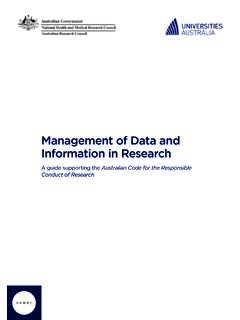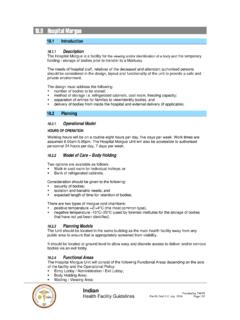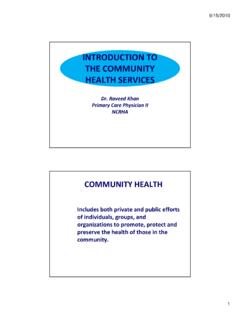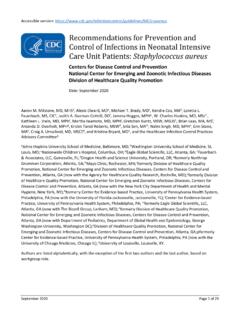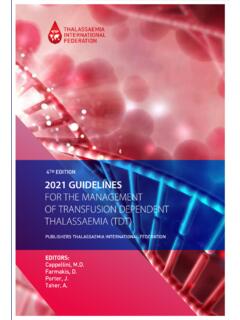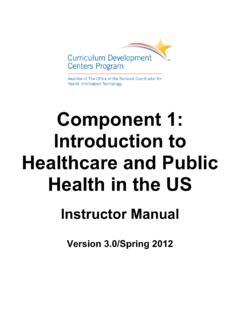Transcription of 5th Edition Staying Healthy - National Health and Medical ...
1 Staying Healthy Preventing infectious diseases in early childhood education and care services(updated June 2013)5th EditionSHIC FRONT 15/06/13 9:01 AMStaying HealthyPreventing infectious diseases in early childhood education and care servicesFIFTH EDITION2012(Updated June 2013) Staying Healthy 5th Edition Commonwealth of Australia 2012 Paper-based publicationThis work is copyright. You may reproduce the whole or part of this work in unaltered form for your own personal use or, if you are part of an organisation, for internal use within your organisation, but only if you or your organisation do not use the reproduction for any commercial purpose and retain this copyright notice and all disclaimer notices as part of that reproduction.
2 Apart from rights to use as permitted by the Copyright Act 1968 or allowed by this copyright notice, all other rights are reserved and you are not allowed to reproduce the whole or any part of this work in any way (electronic or otherwise) without first being given the specific written permission from the Commonwealth to do so. Requests and enquiries concerning reproduction and rights are to be sent to Strategic Communications, National Health and Medical Research Council, GPO Box 1421, Canberra ACT 2600 or via email to Print: 1864965541 Commonwealth of Australia 2012 Electronic documentThis work is copyright. You may download, display, print and reproduce the whole or part of this work in unaltered form for your own personal use or, if you are part of an organisation, for internal use within your organisation, but only if you or your organisation do not use the reproduction for any commercial purpose and retain this copyright notice and all disclaimer notices as part of that reproduction.
3 Apart from rights to use as permitted by the Copyright Act 1968 or allowed by this copyright notice, all other rights are reserved and you are not allowed to reproduce the whole or any part of this work in any way (electronic or otherwise) without first being given the specific written permission from the Commonwealth to do so. Requests and enquiries concerning reproduction and rights are to be sent to Strategic Communications, National Health and Medical Research Council, GPO Box 1421, Canberra ACT 2600 or via email to Online: 1864965568 AcknowledgementsQueensland HealthDr Andrew Langley; Debbie Neucom (RN) Sunshine Coast Public Health Unit, Central Regional Services, Office of the Chief Health Officer NHMRC Project TeamCathy Connor; Tanja Farmer.
4 Marion CareyExpert ReviewersDr Ann Koehler, Communicable Diseases Control Branch, SA HealthDr Kim Drever, Centre Of Community Child Health , Royal Children s Hospital, MelbourneMs Judy Radich, Early Childhood AustraliaDr Celia Cooper, Microbiology and Infectious Diseases Department, Women s and Children s Hospital South AustraliaMs Elise Davis Associate Director, Child Mental Health Promotion, The Jack Brockhoff Child Health and Wellbeing Program, VicHealth Public Health Research Fellow, The McCaughey Centre, Melbourne School of Population Health , The University of MelbourneMs Irene Passaris, Director, Communicable disease Control Section, Health Protection Service, ACT Health DirectorateMs Paula Spokes, A/Manager, Surveillance, Communicable Diseases Branch, Centre for Health Protection, NSW Ministry of HealthTechnical WritersBiotext, CanberraTo obtain information regarding NHMRC publications contact:Email: Phone: Toll free 13 000 NHMRC (13 000 64672) or call (02) 6217 9000 Internet: NHMRC Publication reference: CH55 Published: November 2012 Updated and reprinted: June 2013 III Staying Healthy 5th EditionStaying Healthy 5th Edition updated June 2013 The June 2013 update of Staying Healthy 5th Edition includes fact sheets on croup and warts, which were omitted in the first Edition .
5 NHMRC has also taken this opportunity to make minor amendments to the publication, which are underlined Edition version5th Edition updated version June 201341 Infants need their hands washed as often and as thoroughly as older children: If the infant can stand at a small hand basin, wash their hands the same way you wash your own hands. If the infant cannot stand at a hand basin, wash their hands with pre-moistened disposable wipes; make sure their hands are rinsed with water to remove any soap, then dry need their hands washed as often and as thoroughly as older children: If the infant can stand at a small hand basin, wash their hands the same way you wash your own hands.
6 If the infant cannot stand at a hand basin, wash their hands with pre-moistened disposable wipes, then dry Wash your hands4. Remove the child s nappy and put in a hands-free lidded bin. Place any soiled clothes in a plastic bag12. Clean the change table with detergent and warm water af ter each nappy change2. Place paper on the change table5. Clean the child s bot tom13. Wash your hands3. Put disposable gloves on both hands6. Remove the paper and put it in a hands-free lidded bin7. Remove your gloves and put them in the bin8. Place a clean nappy on the child9. Dress the child10. Take the child away from the change table11. Wash your hands and the child s handsPREPARATIONCHANGINGCLEANING1.
7 Wash your hands4. Remove the child s nappy and put any disposable nappy in a hands-free lidded bin. Place any soiled clothes (including any cloth nappy) in a plastic bag12. Af ter each nappy change, clean the change table with detergent and warm water, then rinse and dry2. Place paper on the change table5. Clean the child s bot tom13. Wash your hands3. Put disposable gloves on both hands6. Remove the paper and put it in a hands-free lidded bin7. Remove your gloves and put them in the bin8. Place a clean nappy on the child9. Dress the child10. Take the child away from the change table11. Wash your hands and the child s hands47 This is the best method to keep the nappy change table clean: After each nappy change and at the end of each day, wash the surface well with detergent and warm water, rubbing with paper towel or a cloth as you wash.
8 Put the paper towel in the bin, or put the cloth aside for washing after each nappy change there will be many germs on this cloth, and it cannot be used again until it has been washed. Leave the change surface to dry. See Section for information on how to clean the nappy change table if the child had diarrhoea. If faeces or urine spill onto the change surface, clean the surface with detergent and warm water and leave it to dry. Halfway through the day, remove the morning change mat or waterproof sheet, clean it with detergent and water and leave it to dry, preferably outside in the sun. Use the fresh mat for the afternoon. Always wash your hands after cleaning the nappy change is the best method to keep the nappy change table cleana: After each nappy change and at the end of each day, wash the surface well with detergent and warm water, rubbing with paper towel or a cloth as you wash.
9 Put the paper towel in the bin, or put the cloth aside for washing after each nappy change there will be many germs on this cloth, and it cannot be used again until it has been washed. Leave the change surface to dry. See Section for information on how to clean the nappy change table if the child had diarrhoea. If faeces or urine spill onto the change surface, clean the surface with detergent and warm water and leave it to dry. Halfway through the day, remove the morning change mat or waterproof sheet, clean it with detergent and water and leave it to dry, preferably outside in the sun. Use the fresh mat for the afternoon. Always wash your hands after cleaning the nappy change To ensure the nappy change table is cleaned correctly, follow the process on page 45 (table ).
10 Celebration cakes and blowing out Celebration cakes and blowing out candles CONTENTSS taying Healthy 5th EditionV CONTENTSS taying Healthy 5th EditionContentsINTRODUCTION 1 Alignment with the National Quality Standards 1 Scope of this Edition 1 Best-practice advice 2 PART 1 Concepts in infection control What causes infections? How do infections spread? The chain of infection Ways in which germs can spread How can diseases spread in education and care services? Main ways to prevent infection Effective hand hygiene 10 Soap and water 11 Alcohol-based hand rubs 11 Antibacterial soap 12 Hand drying 12 Hand care Exclusion of ill children.
